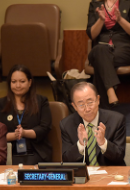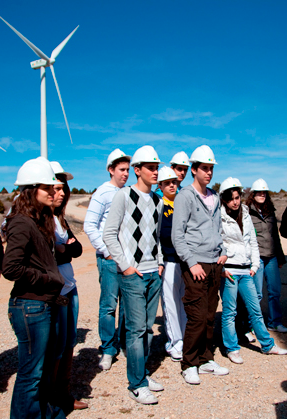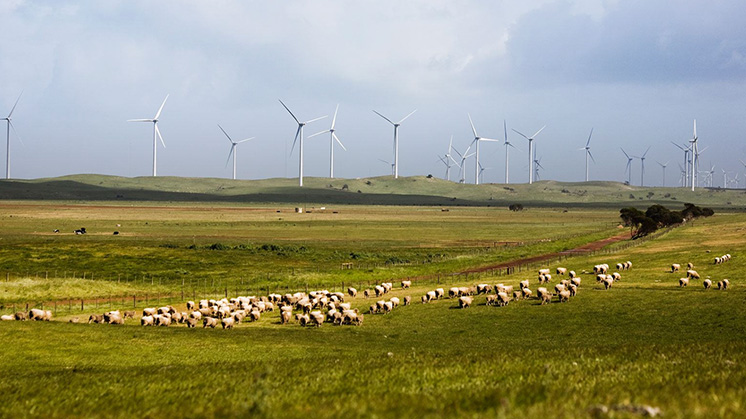Origin of the COP
Why are there different COPs and what is their history?
Climate action Biodiversity Climate change
The environment is facing various threats such as global warming, loss of biodiversity and desertification. Faced with these risks, the United Nations (UN) organises different meetings with the aim of seeking international collaboration. These are known as COPs. We tell you what they are, what types there are and what their history is.
You may have heard of COPs and immediately associated them with climate change. Although these UN conferences are the best known, there are other versions of these meetings that address other environmental objectives or threats. In particular, there are three main risks that underpin international environmental negotiations: climate change, biodiversity and desertification. So, what are COPs, how can we define each of them, and what is their origin?
What are the COPs?
COP is the acronym for "Conference of the Parties". These are high-level conferences organised by the United Nations that bring together states, regional organisations and non-state actors. Any meeting between parties to a convention is officially a COP, although the acronym is often used in reference to environmental negotiations and, in particular, climate change.
The importance of these international meetings in the climate agenda is based on their potential to establish negotiations that define measures to contain the climate crisis on a global scale.
Since when have COPs been held?
The 1992 Earth Summit in Rio de Janeiro was a major meeting on sustainable development that identified three natural processes at high risk: desertification, biodiversity loss and climate change.
Since then, three conventions have been created, each focused on addressing and eradicating each of these environmental impacts, although the best known is the climate change convention, both because of the scale of the problem it represents and the need to accelerate action by governments and business to address it.
The name of the COPs is made up of the acronym and a number, which reflects the edition of the COP, for example COP 27. As the frequency of the COPs varies according to the type of summit, the numbering varies even if they are held in the same year. That is, COP 27 on climate change was held in 2022, but so was COP 15 on biodiversity and COP 15 on desertification, even though they have a different number.
What is the purpose of each type of COP?
Although with similar objectives, each of the three versions of the UN environment conference has its own peculiarities:
 COP on climate change
COP on climate change
The Conference of the Parties on climate change, the most popular meeting, is held annually. These are the meetings organised by the UN following the adoption of the United Nations Framework Convention on Climate Change (UNFCCC), a treaty signed at the 1992 Earth Summit (Rio de Janeiro) that sets out the basic obligations of states (or parties) and the European Union to combat climate change.
These climate summits bring together almost two hundred countries seeking to negotiate joint actions and include a growing number of participants from civil society (private sector, academia, NGOs, multilateral organisations, etc.). The aim is to review the state of implementation of the convention and to propose, evaluate and adopt other instruments to support its implementation in the face of climate change.
The first COP was held in 1995 in Berlin and since then, COPs have been held in different cities in Europe, America, Africa and Asia.
Years after its origin, in 1997, the Kyoto COP 3 agreed on the first legally binding protocol to limit greenhouse gas emissions. It was the so-called Kyoto Protocol in which the signatory countries committed themselves to reduce emissions by at least 5 % (compared to 1990 levels) by 2012.
But perhaps the most famous COP on climate change was the COP 21 held in France in 2015, where the Paris Agreement was adopted. This pact set specific targets for reducing greenhouse gas emissions to limit rising temperatures and the impacts of climate change. While these are the most notable, they are not the only ground-breaking COP agreements on climate change.
Key milestones of the COPs on climate change
1995 COP 1. Berlin 2017 COP 23. Bonn
1997 COP 3. Kyoto
2007 COP 13. Bali
2009 COP 15. Copenhaguen
2010 COP 16. Cancun
2012 COP 18. Doha
2015 COP 21. París
2016 COP 22. Marrakech
2018 COP 24. Katowice
2019 COP 25. Madrid
2021 COP 26. Glasgow
2022 COP 27. Sharm el-Sheij
2023 COP 28. Dubai
1995 COP 1. Berlin
At the first conference, the signatory countries agree to meet annually to keep global warming under control and warn of the need to reduce emissions of polluting gases.
2017 COP 23. Bonn
It marked a major breakthrough in the talks on the Paris Agreement rules and strengthened civil society partnerships and multi-actor collaborative platforms to promote climate action with the launch of the ‘Talanoa Dialogue’.
1997 COP 3. Kyoto
The Kyoto Protocol is adopted with a commitment to reduce greenhouse gas emissions in industrialised countries.
2007 COP 13. Bali
A timetable is set for negotiations on a new international agreement to replace the Kyoto Protocol and include all countries, not just industrialised countries.
2009 COP 15. Copenhaguen
It sets a goal of keeping global warming below 2°C and developed countries commit to long-term financing for developing countries.
2010 COP 16. Cancun
The Cancun Agreements are drafted, formalising the commitments made in Copenhagen, and the Green Climate Fund is established, especially for climate action in developing countries.
2012 COP 18. Doha
It is agreed to extend the Kyoto Protocol until 2020. Some countries such as the US, China, Russia and Canada did not support the extension.
2015 COP 21. París
The Paris Agreement to keep global warming below 2°C compared to the pre-industrial era and to continue efforts to limit it to 1.5°C is unanimously adopted.
2016 COP 22. Marrakech
The roadmap for the implementation of the Paris Agreement and a framework, the ‘Marrakech Partnership’, that would drive civil society participation in the multilateral climate action process were adopted.
2018 COP 24. Katowice
An important part of the Rulebook or technical framework for implementing the Paris Agreement was agreed and the results of the ‘Talanoa Dialogue’ were presented at the highest level. The rules for the global diagnostic that took place in 2023 at COP28 (Dubai) and that serves as a basis for the review of nationally determined contributions (NDCs) at COP30 in Brazil were also agreed.
2019 COP 25. Madrid
Multilateral discussions around the 1.5°C scenario were consolidated and civil society and government partnerships to mobilise short- and long-term climate action were fostered.
2021 COP 26. Glasgow
It gave rise to the Glasgow Climate Pact, a document containing the guidelines for political action agreed between all countries to keep the 1.5°C scenario alive. It was the platform for important political announcements from countries such as China and the United States as well as from blocs such as the European Union. Messages around the need for a just energy transition were reinforced.
2022 COP 27. Sharm el-Sheij
Progress was made on agreements to address the ‘loss and damage’ suffered by countries that are already suffering the consequences of climate change and have few resources to do so. Messages around a just transition, adaptation and the need to align climate action and biodiversity protection were reinforced.
2023 COP 28. Dubai
A very positive agreement was reached to drive forward the energy transition. For the first time, there is an explicit call to move away from fossil fuels under strict conditions: accelerating climate action in this decade, achieving net zero emissions by 2050 and basing action on science. In addition, a target of tripling renewable capacity and doubling energy efficiency improvements by 2030 was set.
 SEE INFOGRAPHIC: Key milestones of the COPs on climate change [PDF]
SEE INFOGRAPHIC: Key milestones of the COPs on climate change [PDF]
 Biodiversity COP
Biodiversity COP
The Conference of the Parties on biodiversity is held every two years. It is based on the UN Convention on Biological Diversity (CBD), a 1992 multilateral international treaty that aims to achieve a sustainable future, conserve biological diversity and promote its sustainability, and enhance the fair and equitable sharing of the benefits arising from the use of genetic resources. It has been ratified by 195 countries, plus the European Union, but not by the United States or the Vatican.
The COP on biodiversity steers, oversees and decides on the process of implementation and further development of the Convention on Biological Diversity through analysis and discussion of the agenda items.
The first one took place in 1994 in Nassau (Bahamas) and since then it has been held in different cities in Europe, America, Africa and Asia.
Among the most relevant events of these meetings is the approval at COP 15 (2022) of the post-2020 Global Biodiversity Framework, which is conceived as the most ambitious global plan ever developed for this environmental cause. It includes targets such as conserving at least 30% of the world's terrestrial, marine and coastal areas and restoring at least 20% of each of the world's degraded freshwater, marine and terrestrial ecosystems, among others.
 COP on desertification
COP on desertification
The Conference of the Parties on desertification is also held every two years. It stems from the United Nations Convention to Combat Desertification (UNCCD) which constitutes, together with the United Nations Framework Convention on Climate Change and the Convention on Biological Diversity, the triptych of multilateral environmental agreements created at the Rio Summit in 1992. The UNCCD was adopted in Paris in 1994 and has been ratified by 196 states and the European Union (EU).
The objective of this Convention is to combat desertification and mitigate the effects of drought in particularly affected countries - especially in Africa - through effective measures supported by international cooperation and partnership agreements. The first COP on desertification was held in 1997 in Rome.
The future of the COPs
The three conventions are fully interlinked and will see an augmented need for alignment of their agreements and actions as the impacts of climate change intensify, negatively affecting biodiversity and driving desertification. Until now, the Climate Change Conference, the Biodiversity Conference and the Conference on Desertification have met independently of each other. However, more and more actors and participants are insisting on the need to seek cross-cutting solutions to these environmental threats and even to unify the three types of conferences. The role of civil society, especially the private sector, will be increasingly important in implementing the agreements reached at each of the three COPs.
Iberdrola in the COPs
The Iberdrola Group, a world leader in the fight against climate change, is intensely active within the framework of the global debate on climate policies, actively participating in the main milestones of the global agenda, such as UN summits.
After years of involvement in the COP on climate change, we played a leading role and actively participated in COP30, held in 2025 in Belém (Brazil), where we took part in the main events on electrification organised, one of them led by the We Mean Business Coalition (the leading global business climate organisation) and another organised in collaboration with the Presidency of the climate summit. During the summit, Iberdrola's chairman, Ignacio Galán, defended the role of investment in electricity grids, the expansion of renewable energies and the promotion of storage as tools to strengthen energy security and autonomy, generate opportunities for growth, employment and industry and, of course, advance in the fulfilment of climate objectives.

"The goals are achievable, but the hard work to achieve them starts today. That means mobilising huge investments in renewables, as well as in grids and storage, the other two critical pillars for a stable energy transition. Governments must also quickly address the barriers that have been present in the past, such as allowing delays and ensuring stable and positive frameworks for investments."
Ignacio S. Galán
Executive Chairman of Iberdrola
Over the last 25 years, the Iberdrola Group has invested nearly €175 billion to advance electrification through electricity grids, renewable energy and storage, which has increased strategic autonomy and security of supply and improved competitiveness, while promoting development and social progress.
We also participate in Biodiversity Summits. In 2024, we also attended COP16 in Cali, Colombia, the latest edition of this type of meeting, where we continued with the objectives set out in the Biodiversity Plan [PDF] that we presented at the previous COP15 biodiversity summit in Montreal (Canada). This plan establishes the necessary mechanisms to ensure that by 2030 our activity contributes to creating better environmental conditions than those that existed previously. To this end, we have set ourselves the goal of achieving a net positive impact on ecosystems and species wherever we operate by 2030, and we have established an innovative accounting framework for quantifying the impact of our actions on ecosystems.

Paris Agreement
Key points of the Paris Agreement.

International agreements
Searching for consensus on the fight against climate change.

Climate awareness
Raising social awareness on climate change.

Day against Climate Change
Aware of climate change.





